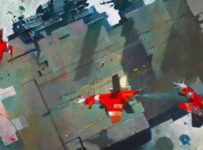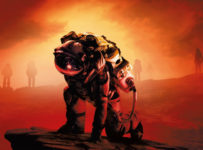
Sookie Stackhouse returns for round two, and Charlaine Harris decides that one story isn't enough: she needs to nestle a second one inside the first, like some sort of weird matryoshka doll of bizarre pacing choices.

Sookie goes to work one morning to find that her coworker Lafayette has been murdered and left in the back of local detective Andy Bellefleur's car. This does not concern her, however, because she is contracted out to Dallas to use her telepathy to find a missing vampire. After tangling with a vampire hating cult over state lines, she comes back and attempts to solve that murder.
The Dallas segments of the book introduce interesting key concepts such as the underground shapeshifter and werewolf societies and The Fellowship of the Sun cult. The way that Harris writes, however, gives basically everything that happens to Sookie equal weighting. "I'm in a fancy vampire hotel in Dallas!†is relayed with exactly the same gravitas as "I'm being thrown into a dank cell, albeit I'm less happy about this development than I was about the hotel!†You can't tell how significant an event is going to be simply from your progress through the pages because the banal and the notable are practically the same, and narrative development is haphazardly thrown in wherever Harris feels like it.
Still, the Dallas segment of the book is consistently interesting if slightly rushed off its feet, and is more successful for world building than anything else.
I think that Harris is more taken with her characters than she is with logical plotting, although I will admit that a police investigation of a murder doesn't strictly fall under Sookie's purview. It's strange because Sookie goes and completes her Dallas work, waits a few weeks, and then realises "Man, the police haven't got anywhere with that murder investigation! I'd better go and use my telepathy at a sex party! The situation that led to everyone seeing me topless at the beginning of my adventure will suddenly pay off here!â€
This murder plot isn't even cleverly parallel to the Dallas plot; it's just something that happens because there's enough pages left to deal with it. The resolution of this plot is grounded entirely in Sookie's prejudices; the party or parties responsible for the killing are not bad because they have killed someone but because of their sexual predilections. Sookie doesn't believe in sex without love and believes in premarital sex only because she's not allowed to marry a vampire (also because she really likes sex), and so these hedonists must suffer.
This of course leads into the other flaw with the concept of law and order and vampires: there is no point in police and justice if supernatural beings are just going to kill people and then destroy all evidence that they've done so. It doesn't really work like that and Harris should stop pretending that it does. The conclusion is so neat it beggars belief, and there will never be proper criminal procedure in the world of Sookie Stackhouse.
Something that was mentioned in the first book becomes more apparent here: the people of Bon Temps are Civil War fanatics. Sookie's grandmother refers to it as "The War of Northern Aggressionâ€. The issue of race in the books isn't as thorny as it could be because Sookie makes a point of being generally accepting of everyone while making clear precisely what colour most of the characters' skins are.
The point I'm trying to make is that not only is it difficult to get my head around the fact that this is a book set in a place where they think that the South was the right side in the Civil War, but they live in a world where Bill Compton is a vampire who fought for the South in that self same war. It's difficult to go into 150 year old politics in a book about vampires but it's hard for me to fathom a series in which realistically a lot of the characters are down with the concept of slavery.
I write this of course as someone completely removed from that equation, but I think that it's a prejudice I'm allowed to have. Coming back to this segment a few days after I wrote it, I realised the completely obvious: that human/vampire relations are a thinly veiled allegory for miscegenation. Racial tension is barely examined in these books (which means that Sookie mostly ignores it), but it undoubtedly exists.
Regardless of my issues with the plotting and skimming of various social mores presented in the book, Harris has done some good character work. Sookie’s priggishness gets old, but her relations to the other characters are well defined and we get a better sense of Eric as the book progresses. Despite her love for Bill, we also get the impression that she doesn’t necessarily like him all that much, and she can’t exactly be blamed for that. Harris allows the ideas that romance is imperfect and that some couples might not ultimately work out to seep into the pages, and this will probably upset some readers (vampiric love is eternal, after all), but it’s a brave move for what, in some ways, amounts to a literal bodice ripper.
Admittedly, Jason gets a free pass for homophobia (“everyone’s allowed a weakness”, apparently), and everyone is perceived through the lens of the high-minded Sookie, but a definite sense of all of these people in one way or another is the book’s strongest asset. Harris should pay closer attention to her dialogue (Sookie explains twice in one conversation that she’s a telepath, and only gets a response to that the second time she says it), but otherwise this is smooth work.
Living Dead in Dallas isn't a bad book, even though I sound pretty down and terribly sarcastic on most of it; I just suspect that it takes longer for me to write one of these reviews than it takes to read the books themselves, and possibly longer than it takes Harris to construct them. I'm probably supposed to burn through these books and then ignore them, but I don't work like that. It's easy to analyse pulp by virtue of its pulpiness, so I'll continue to do that, and hope that I'll maintain my sanity. Given that the follow up introduces new and further problematic story and character elements, we shall have to see.


